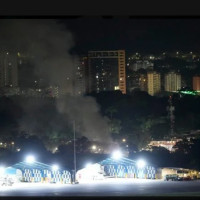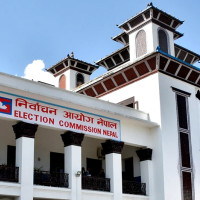- Saturday, 3 January 2026
Overnight rains raise hope of paddy plantation
By A Staff Reporter,Kathmandu, Aug. 3: People in the Tarai region felt relieved after long-awaited rainfall arrived on Thursday night. Since the onset of the monsoon season two months ago, the area received only 30 to 40 per cent of the average rainfall by August 1, which had hampered the seasonal paddy plantation.
According to Hari Prasad Dahal, a meteorologist at the Meteorological Forecasting Division under the Department of Hydrology and Meteorology (DHM), only a few areas in Madhes Province received heavy rainfall, while most areas saw moderate rain.
He said that the Tulsi and Hardinath stations in Dhanusha recorded 78.4 mm and 51 mm of rainfall respectively in the past 24 hours, which
is heavy rainfall. The Tarai region is forecast to receive moderate to heavy rainfall for a few more days, which will benefit paddy plantation in the remaining fields, Dahal said. Meanwhile, Ravindra Upreti, our Bardibas correspondent, reported that after a long dry spell, the overnight moderate to heavy rainfall has brought relief to farmers.
On Thursday night, the Chure area, including Bardibas, experienced the heaviest rainfall of the year so far. It also caused the first flood of the year in the rivers flowing from the Chure hills. Water has also started flowing in previously dried-up canals. The rain, which began heavily around midnight, continued as light showers until Saturday morning. This signals that the monsoon is now becoming more active. The sky is covered with thick clouds and on Saturday too, light to heavy rain was reported in Bardibas and nearby northern areas.
The rain has brought much-needed moisture to dry canals and cracked fields, giving hope to farmers.
In Bardibas-5 Tuteshwar, farmer Balkumar Ale started planting rice on 10 katthas of previously fallow land after the rainfall. He said, “By this time last year, we had already finished planting and started weeding the paddy. But this year, though the seedlings were ready, we were only able to begin planting after the good rain last night.”
The rain also reached the southern parts of the region, but farmers there said the rainfall was lighter than in the north.
Devanand Ray, head of the Agriculture Knowledge Centre in Mahottari, said that although the southern area received less rain, the heavy rain and floods in the Chure hills will help recharge water sources in the south.
He said, “The rain in the Chure region increases the chance of water returning to dry canals in the southern plains. Even a small amount of rainfall has helped the paddy fields.”
Thanks to the rain, even farmers who use shallow tubewells for irrigation have found it easier to plant.
Farmer Satyanarayan Yadav from Bharatpur, Gaushala-9, said, “Now, instead of needing to run the boring pump for six hours, we can manage with just two or three hours.”
According to the Agriculture Development Directorate, out of the total 372,645 hectares of paddy fields in Madhes Province, only 57 per cent (213,438 hectares) has been planted as of August 1.
Mahottari had the lowest rate at 40 per cent, while Parsa had the highest at 85 per cent.
Sudip Chaudhary, a crop protection officer at the Directorate, said that if the weather continues to favour, the paddy plantation rate could rise significantly in the coming week.
















